| |
The Slugger and the Singer
Here we recall the efforts of two people in Germany in the early
1950s, LTC Ralph F Miles and Ms. Annette Markell. They were
innovators possessed of imagination and drive that took them from
what they saw to what they wanted to see. The events pass through
Bad Kissingen for brief seconds, really these are Bad Hersfeld
centered stories but the troopers at Daley Barracks probably knew
their names and might even smile at the recollections.
A soldier and boxer, a song writer and troop entertainer - such
decidedly different people but so much the same. Let’s clear the
ring, set the starting line, bring down the house lights and
remember that passion and vision can lead to events greater than
imagined.
Battledown and the Charity of Sport
Touchdown! - The Musical.
___________
The Preliminary Bout and Overture
 1950: The 24th Constabulary Squadron in the Hessian - Bavarian
Border Region and Overall Environment 1950: The 24th Constabulary Squadron in the Hessian - Bavarian
Border Region and Overall Environment
The US Constabulary mission in Germany was changing as units begin
to consolidate, were relieved of duty or reassigned. The missions
that led to the creation of the force only a few years earlier:
civil policing, control of refugees, suppression of smuggling and
maintenance of general order were rapidly passing away.
The local German police forces were very quickly reestablished at
the end of the war, this led to a return of general civil order and
a gradual yet steady control of smuggling.
The refugee problems were daunting but between the Allied forces and
the United Nations Relief Organization, a degree of order was
imposed over the hundreds of thousands of people adrift in Germany.
Some were deported, many more were resettled - seldom the best
solution but often a pragmatic balance. The days of Constabulary
troops putting down riots in DP camps had passed, the road patrols
were ending, putting on a crisp uniform to stand watch in some town
was not necessary.
The East - West German border region remained a problem and here,
the US Constabulary mission lingered. As political differences
between East and West became apparent, and the first runs of barbed
wire went up, clearly some American units with some level of
operational expertise was needed to maintain a continuity on the
border.
Behind them, deeper in Germany, combat units were being formed, were
receiving new equipment and training. For the moment, the
Constabulary units in the border area were the watchers - they knew
the area, the trails and terrain. In Hesse and North - Central
Bavaria - the men on the border were from the 24th Constabulary
Squadron.
Semper Custos
The 22nd Constabulary Squadron was re - flagged to the 24th
Constabulary Squadron in late 1949. Their border patrol mission ran
from the northern point of the US Occupation Zone, Hebenshausen to
Cobug in the south, a distance of 225 miles. From Coburg running
southeast, border responsibility belonged to the 15th Constabulary
Squadron. Squadron HQ for the 24th and A & B Troops were at Hersfeld
with D Troop at Fritzlar and C Troop stationed in Schweinfurt. In
mid 1951, C Troop moved to Bad Kissingen along with the 2 - 14th
Recon Battalion.
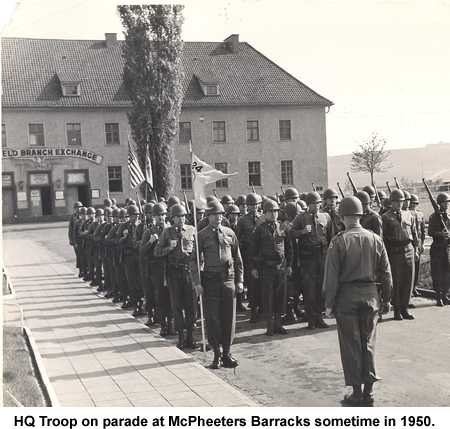
The 24th was subordinate to the 14th Armored Cavalry Constabulary
Regiment and once the 14th was designated to shed the Constabulary
role and re - equip as a combat formation, the roles over the next
few years were set. Men of the 24th patrolled the border while men
of the 14th ACR began the training process to return to a combat
role and in this capacity, the 24th survived to be one of the last
Constabulary units in Germany.
The line Constabulary Troops were hardly the large units one might
expect to find in a recon outfit. Platoons averaged about 21
personnel, they had jeeps and M3 six wheeled patrol cars - the
standard Constabulary equipment set. From 1950 until the end of
their mission in early 1953, as Constabulary units were drawn down
elsewhere in Germany, some men and equipment filtered to the 24th
but the reality was the units transforming back to the combat TO &
E’s had first priority and many times, the 24th felt it was under
manned with old equipment and sagging soldier morale. Something
needed to be done.
It was certainly a challenging environment for officers, NCO’s and
men. Creativity and innovation were the Orders of the Day. Long days
and nights on the border trails might have been common, but many
troopers would fondly recall the aggressive sports programs and
outreach to German charities that they found with their units in
Hersfeld, Fritzlar and Schweinfurt / Kissingen. And what about the
entertainment?
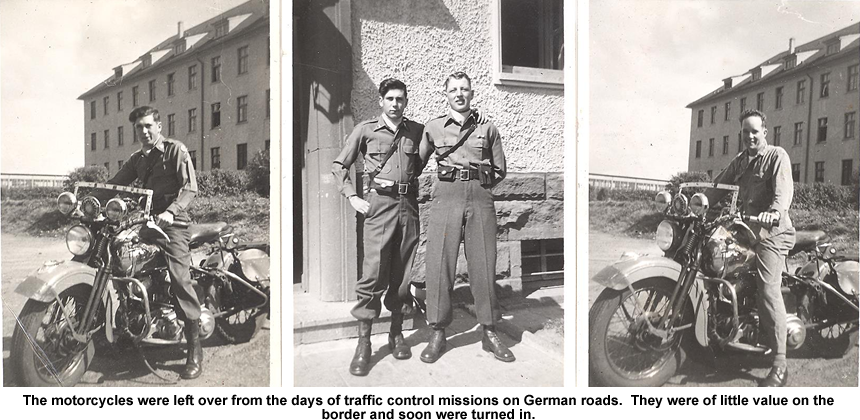
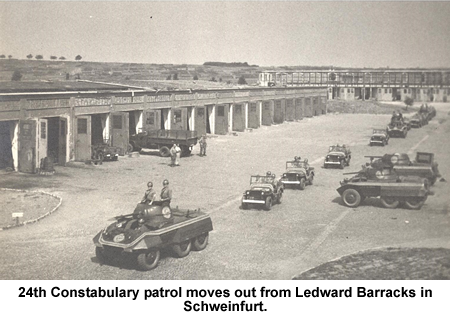 Battledown! Battledown!
Life Magazine
20 March 1950
Mayhem in the Mud
“ In 1943, an Army Major named Ralph Miles, remembering the
childhood game of “ capture the flag “ invented an adult version
which he called “ battledown “. Designed to toughen recruits and
provide training in tactics and leadership, Battledown had more in
common with Bastogne than with any boys game. Last Fall, when he was
stationed at Camp Hood, Texas, Major Miles introduced his game
there. Recently eight battalion teams from the 2nd Armored Division
squared off in the mud for a battledown tournament. “
“ The 35 members of each team, wearing boxing gloves, attacked from
opposite ends of a field obstructed by hummocks and muddy pits.
Almost any type of assault was permitted, the objective being to
down the opponents flag. The game is not especially popular with the
men, who call it “ murder pits “. The Camp Hood tourney resulted in
no fatalities but it produced 11 minor casualties and some of the
muddiest Americans since Guadalcanal. “
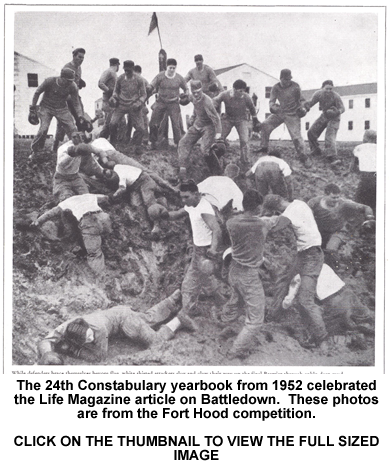
And the Charity of Sport
Following assignments during the war, Major Ralph Foster Miles
departed for Germany and a position as Deputy Squadron Commander,
24th Constabulary Squadron, located at Bad Hersfeld. He was
passionate about sports, the more physical the better and
particularly, boxing.
Years earlier, while attending a prep school in upstate New York and
for a short period after, he fought in an unsanctioned club circuit
and then while at Saint Lawrence University, fighting under the name
of “Red O’ Brien “ he had ten professional fights and a 4 win / 4
loss and 2 draw record. A significant football injury from prep
school days hobbled his ring skills, he was happy to get up off the
canvas and gain a draw in his last fight and Miles was ready for a
new profession. He joined the Army in 1933, gained a commission and
served stateside in the years preceding the war.
Little is known of his war record. The 1952 24th Constabulary Unit
Yearbook reported that while stationed at Fort Knox in 1943, Major
Miles had run the first Battledown competitions. He then served with
the Americal Division in the Pacific. By 1950, he is at Hood, has
resurrected Battledown and Life Magazine ran the story through which
he gained a brief moment of notoriety, not only with the public but
apparently the Department of the Army as well. They saw some value
in the “ mayhem in the mud “ and asked him for the official rules.
Later that year, Major Miles was reassigned to the Constabulary in
Germany and the HQ 24th Squadron at Hersfeld. A local US Newspaper
ran a brief article on Ralph Miles with this quote, “ guts, speed
and the desire to win “ , were the goals of Battledown. The rules -
few: force on force, 35 men per team with boxing gloves in a muddy
field. Capture the flag meets Mad Max and Thunderdome. Charge
through the mud, climb the muddy hill, take the flag and win the day
- the best reward is that the game is finally over.
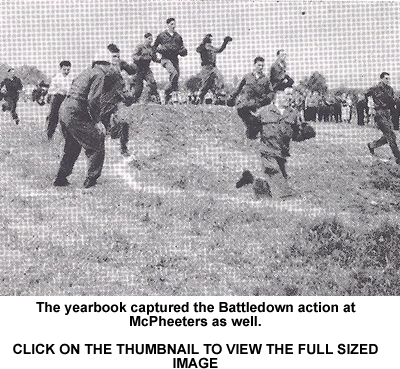
Some decades later, tuff mudder ((https://toughmudder.com/ ))comes
to pass and you have to pay for the privilege of mud an’ blood but
that is yet another story.
How many times was Battledown visited upon the soldiers of
McPheeters Barracks is anyone guess. The yearbook features a series
of photos that appear to all be from the same event so perhaps it
was only approved as a one - time - only fracas. Finding veterans
for that unit has been problematic so, there are no first hand
recollections. Thanks … Major Miles!
The Sweet Science and Track Stars
Battledown may have garnered some local headlines and left many
troops with sore ribs but this was hardly Major Miles’ most lasting
contribution to the Constabulary. Through his vision and force of
will, he instituted a series of boxing and then track and field
events, his “ Summer Games “ that brought military athletes from
three countries and German sports clubs together in fellowship and
completion with the ticket sales proceeds going to local German
charities. A grand impresario of amateur sport.
The 24th Constabulary at Hersfeld had taken over a few previously
established outreach to local German population programs from the
22nd Constabulary to include significant sponsorship of a local
orphanage. The unit yearbook recalls that in 1951, Miles and his
boss, SCO LTC Perry E Conant, wanted to increase the American level
of support and create new programs to improve local relations. And
it should be noted, these Army unit supported charities in Germany
were not unique to the border region and in fact were more or less
expected in each garrison town. Doing the minimum is one thing,
doing more than expected was quite another.
Operation Chrysler was one of their first projects, a raffle open to
both Americans and Germans, first prize - a new American car. Where
they got the money to secure the car and who actually won is
anyone’s guess, but the yearbook reported a net profit of over $1800
dollars, all of which went to either the orphanage or other worthy
charities.
Among other local initiatives from this period were a German Soap
Box Derby race for kids, a Summer Camp sponsorship and greater
involvement with the local German - American Youth Activity Club (
GYA ) in Hersfeld.
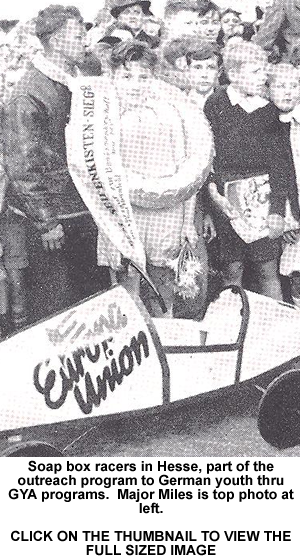
All of these activities no doubt, helped relationships between the
troops and local population but money can only take you so far.
Major Miles wanted to get more troops actively involved in all
sports and he oversaw a significant change to the local unit sport
programs. The 1952 Summer Olympic Games were to be held in Helsinki
and no doubt, this was in the back of his mind as he took stock of
the local athletes, German and American.
Fighting for Friends
The 24th Squadron had a robust amateur boxing program that pitted
Company against Company and Miles asked, “ why not open the ring to
local German fighters as well ?“ Tickets could be sold, charity cash
flow increased and this would allow more troops to directly
participate. The idea took some careful selling, particularly to his
superiors. In 1950, the war was only over for a comparatively brief
time and American troops and local Germans had frequently brawled in
the bars and downtowns of dozens of German cities much to the
consternation of both elected leaders and unit commanders. The fear
was that what started in the ring could easily spill over into the
audience and a good time would be had by none.
In an article from the Rochester Times Union recalling Major Miles
and boxing in Germany, it was reported that the crowd was a little
tense the first time the open boxing matches were held, but good
refereeing kept things in hand and “ an equal number of German and
American boxers hit the canvas. “ The Army boxing shows occurred at
McPheeters gym on a monthly basis and were very popular.
It seems safe to say that men of Schweinfurt and later Bad
Kissingen’s C Troop participated in all of the 24th Constabulary
sporting events - there are just no records recalling specific names
or dates.
The biggest boxing event at Hersfeld occurred in the Summer of 1952
with an outdoor show featuring the famous German professional
fighter, Max Schmeling in attendance. He had only retired from the
ring a few years earlier and was famous from his many epic bouts in
the USA during the pre war years in the heavy weight class fighting
Joe Louis and other notables of the era.
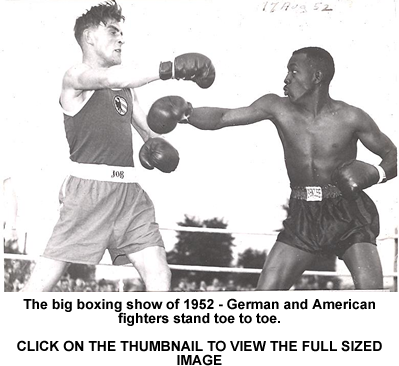
Miles was instrumental in getting Schmeling, a German executive with
American Coca Cola, ringside and in fact he was the guest referee
for a couple of the exhibition bouts. The local Germans of Hesse had
never seen Schmeling in person and Boxing Magazine reported that
over six thousand Americans and Germans were in attendance with over
one thousand dollars pouring into 24th Squadron charity coffers
destined for the GYA Summer camp fund.
The Summer Games
Monthly fights were just fine, but the Constabulary troopers of
Hersfeld had bigger plans. To what extent Miles was directly
involved is unclear, but it seems a safe bet that once the German -
American boxing program was a hit, something truly spectacular was
needed as an encore. Why not a full day of track and field games
open to German, French and British participation?
LTC Conant had been a track star in college, he certainly like the
idea.
The idea of inviting British and French soldier participants
probably had its origin when the 24th sponsored a fencing tournament
held in 1950. There were a few soldiers with fencing experience in
the unit, to find suitable matches, the squadron invited members of
the French Army stationed in far western Germany and British troops,
arrayed along the border to the north of Hersfeld. Very little was
reported about the event but it set the groundwork for what would
evolve into the grand Summer day of games.
To raise the most money for the various charities to include the
24th’s ambitious plan to build a new local orphanage, you needed a
big event and the Summer Track and Field Competition was born. The
first games occurred in 1950 with the German Sports Clubs dominating
the field against an American team made up of mostly 24th
Constabulary troops. Much larger programs were held in 1951 and 1952
with participation by additional American units and soon the medal
counts were more even.
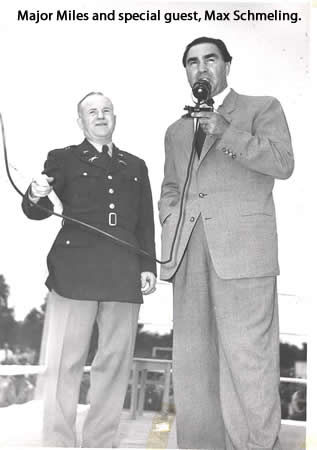 Similar to the fencing exhibition, teams were sent from French and
British forces and local German sports clubs from nearby towns
offered their best athletes. For the Americans, there were men of
the Squadron, the 14th Armored Cavalry Regiment and other American
units in the area. Similar to the fencing exhibition, teams were sent from French and
British forces and local German sports clubs from nearby towns
offered their best athletes. For the Americans, there were men of
the Squadron, the 14th Armored Cavalry Regiment and other American
units in the area.
Photographs of the events show many General Officers in attendance
and on probably the biggest game day, 1952, French Moroccan Colonial
Troops provided an 85 man military band complete with a mascot goat;
the 4th US Infantry Division sent their band and a regional German
police band added to the grand procession.
Hersfeld became a host city devoted to the event and attendance for
the 1952 competition was estimated at over 4000 people. The events
lasted a single day, from early morning to a final medal ceremony
and parade near sundown. The funds to keep the orphanage
construction underway were pretty much in hand at the end of the
day.
And Then it was Over
In 1953, the games did not occur, the open boxing was finished and
so was the 24th Constabulary. In late December 1952, the unit handed
the border mission off to the 14th ACR and cased colors. Personnel,
including the men of Troop C at Kissingen, were either reassigned or
returned stateside and Miles, at least for a short period, was
transferred to the 3rd Bn 14th Cavalry. However, he was not quite
out of the spotlight.
In 1953, he was reassigned to a post in California supervising
reserve units. The construction budget of the orphanage was $50,000
dollars and Miles, through his fund raising efforts, had contributed
$10, 000. He wrote from his new assignment to the German Youth
Activity office at Hersfeld asking whether the final money had been
collected to finish the building and expressed hope that the 3rd
Battalion of the 14th Armored Reconnaissance Regiment, would somehow
continue the sports and outreach programs that had been so
successful under his watch.
As more months passed, and planning for the dedication of the
orphanage began, Hersfeld Major Otto Jansen and other notables in
the region began a letter writing campaign to lobby that LTC Miles
be allowed to return to German for the formal opening of the
building. Among the recipients of the letters were President
Eisenhower and 7th Army Commander, Lt Gen McAuliffe. Needless to
say, the Army could not say no.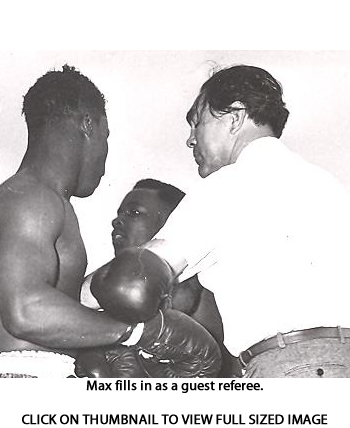
On August 20, 1954 at a ceremony with over two hundred Germans and
Americans in attendance, the new orphanage was dedicated, a three
story building to accommodate sixty children. LTC Ralph Miles was
present, gave brief remarks and then signed over the rights to a toy
war game he had invented that was scheduled to go into production
that year. Any profits from sales would flow to the orphanage or
other local charities. When finally totaled, he had overseen the
raising and contribution to local charities of over $40,000 from
1950 until 1953.
Through the following years, the three battalions of the 14th did
support the local German orphanages in Fulda, Kissingen and Hersfeld
although at a much lower financial level. By the time the mission
was handed off to the Blackhorse - this relationship with German
kids was a pleasant anachronism from a long past time.
Likewise, German - American Youth Activities and clubs were no
longer the concern of American military units after 1955. It was
once a good idea and then, the recovery of the German economy and
much closer control over military units and fund raising involving
lose cash signaled the end of the program. Close the books on the
project and let’s move on.
While unit sports to include track and field and boxing would remain
options for troopers in the 14th , the days of the grand games,
French and British participation and German teams had likewise past.
The 1952 14th Armored Cavalry Yearbook makes no mention of German
American sports events. This seems odd, but perhaps the Regiment
wanted to officially separate itself from what had been a
Constabulary initiated event.

At any rate, the Cold War was on, the recon battalions had much to
do with all the expected training, exercises and maneuvers plus the
border mission. German - American competitions were limited to rifle
and pistol marksmanship on the ranges and the occasional fists up
and dust - up at the Volksfest beer tent.
The orphanage today appears to be in use as an Alsheimer’s Disease
residence.
LTC Ralph Miles retired from the Army in 1961, settled in California
and died in 1996. His activities during this period are unknown but
chances are, at a backyard cookout, get together with friends or
encounter with an old Army buddy - tales of Hersfeld, the games and
Battledown would soon be heard. And hey! Did he tell the story about
the singing soldier musical??
Touchdown! The Musical
Big name celebrities touring Germany and putting on shows were a
rarity in the early 1950s with the exception of the Annual Holiday
Tours organized by the USO. Troop entertainment efforts saw local
soldier talent performing at the unit level in regional shows and
reviews and this included Special Services efforts with the 24th
Constabulary Squadron and the 14th ACR.
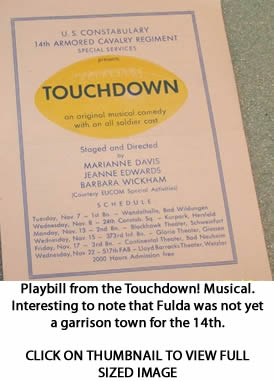
An on going problem was the lack of women participants. There just
weren’t that many female soldiers assigned to Germany, fewer still
who wanted to participate in EUCOM Special Services productions and
shows and the idea of mixing dependants with troops in these
endeavors was not looked upon highly.
The solution was to rewrite the stories as much as possible to
reduce the number of actresses to a minimum and then draw upon
Special Services talent to play the remaining female roles. Many of
the SS employees had some entertainment background; it was the best
solution possible and it apparently worked pretty well.
A surviving artifact from that period is this playbill that
acknowledges the efforts of Special Services workers: Marianne
Davis, Jeanne Edwards and Barbra Wickham in dreaming up a musical
that required a single actress and would be well received by the
troops.
But maybe there is a little more - These names do not readily appear
in Broadway history - Davis has a single credit but it easily could
be another woman. Regardless of their backgrounds, their intentions
were great and the results were … well BoFFo!
Imagine, a romantic comedy, singing and dancing with 25 soldier
actors / dancers / chorus and one woman - I guess she like her odds
of getting a guy by the last act!

But hold the presses! What about Annette Jacobs Markell! The
playbill gives her credit for two of the non professionally sourced
songs: “ Ain’t got Dames “ and “ Entered the Institute “.
Well, Ms. Markell was the creative song writer responsible for these
two tunes; a graduate of University of Nebraska - Class of 1948 -
with a degree in Music in Education, she found her way into the
Special Services, went to Germany and upon return to the USA, raised
a family, worked in the California School System and has been a
creative force in local theater for over 35 years. Sing you soldiers
and sing you citizens and let‘s see if she can scribble out a few
tunes to get this show on the road!
As is often the fact, the script and music is now lost from these
EUCOM productions but doing just a bit of digging, the “ all
original musical comedy “ was in fact assembled out of the rough
plot lines and song sheets borrowed from a number of period musicals
and popular songs, plus the occasional original work. Chances are
good that the musicians of the trooper band, the audience and
performers were already familiar with many of the songs now merged
into a story they might recall from a movie few years back. A
strange brew, a happy story, some well known songs and something new
on the stage.
Touchdown - Book and Score

A couple of the songs seem to be borrowed from the 1941 musical then
movie, Best Foot Forward, the story of how a lone girl sneaks into a
military prep school following her boy friend. This plot line was
merged with another period show, Good News, that saw a college
student librarian tutoring the star quarterback and then the budding
romance - tunes Varsity Drag and Pass the Peace Pipe came from this
source.
A much older show, Rose Marie, contributed the song Totem Tom Tom.
The 1946 movie Sweetheart of Sigma Chi contributed the Sweetheart
song and the last two songs were the product of a Special Services
writer, Annette Markell. Of the twelve musical numbers in Touchdown,
only four required the participation of the sole female singer, many
were designed for an all male chorus and almost every song would
have been familiar to the audience.
When the curtain came down and the footlights came up - no doubt a
good time had been had by all Constabulary troopers. A little bit of
Hollywood, a little bit of Broadway, a little bit of hokum and a lot
of effort from the Army troopers and gals of the Special Services.
What a great night at the theater they had in Germany - 1950!
Touchdown Songs and Sources
| I am Working my Way Through College |
Best Foot Forward ?? |
| Buckle Down Winsocki |
Best Foot Forward |
| When I First Entered the Institute |
Special Services: A J Markell |
| We Ain’t Got Dames |
Special Services: A J Markell |
| |
|
| The Stars Remain |
Band Leader Woody Herman: Standard |
| It Only Happens When I Dance with You |
Easter Parade |
| |
|
| Sweetheart of Sigma Chi |
Sweetheart of Sigma Chi |
| Totem Tom Tom |
Rose Marie |
| Pass that Peace Pipe |
Good News |
| |
|
| Prisoner of Tate |
Good News |
| You’ve got to be a Football Hero |
Band Leader Fred Waring: Standard |
| Varsity Drag |
Good News |
| |
|
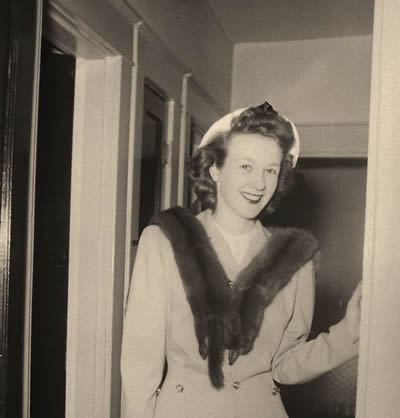 |
|
Annette Markell in 1949. She contributed two
songs to the musical that held the plot together and kept
the show on the road. What a trooper! |
March 2016
|
|